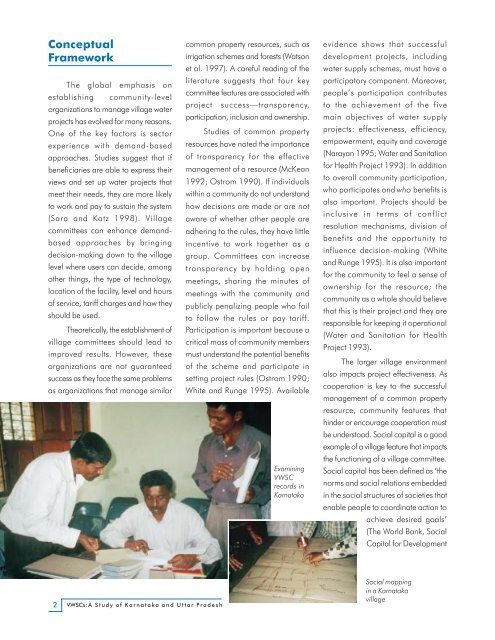Why Some Village Water and Sanitation Committees are ... - WSP
Why Some Village Water and Sanitation Committees are ... - WSP
Why Some Village Water and Sanitation Committees are ... - WSP
You also want an ePaper? Increase the reach of your titles
YUMPU automatically turns print PDFs into web optimized ePapers that Google loves.
Conceptual<br />
Framework<br />
The global emphasis on<br />
establishing community-level<br />
organizations to manage village water<br />
projects has evolved for many reasons.<br />
One of the key factors is sector<br />
experience with dem<strong>and</strong>-based<br />
approaches. Studies suggest that if<br />
beneficiaries <strong>are</strong> able to express their<br />
views <strong>and</strong> set up water projects that<br />
meet their needs, they <strong>are</strong> more likely<br />
to work <strong>and</strong> pay to sustain the system<br />
(Sara <strong>and</strong> Katz 1998). <strong>Village</strong><br />
committees can enhance dem<strong>and</strong>based<br />
approaches by bringing<br />
decision-making down to the village<br />
level where users can decide, among<br />
other things, the type of technology,<br />
location of the facility, level <strong>and</strong> hours<br />
of service, tariff charges <strong>and</strong> how they<br />
should be used.<br />
Theoretically, the establishment of<br />
village committees should lead to<br />
improved results. However, these<br />
organizations <strong>are</strong> not guaranteed<br />
success as they face the same problems<br />
as organizations that manage similar<br />
common property resources, such as<br />
irrigation schemes <strong>and</strong> forests (Watson<br />
et al. 1997). A c<strong>are</strong>ful reading of the<br />
literature suggests that four key<br />
committee features <strong>are</strong> associated with<br />
project success—transp<strong>are</strong>ncy,<br />
participation, inclusion <strong>and</strong> ownership.<br />
Studies of common property<br />
resources have noted the importance<br />
of transp<strong>are</strong>ncy for the effective<br />
management of a resource (McKean<br />
1992; Ostrom 1990). If individuals<br />
within a community do not underst<strong>and</strong><br />
how decisions <strong>are</strong> made or <strong>are</strong> not<br />
aw<strong>are</strong> of whether other people <strong>are</strong><br />
adhering to the rules, they have little<br />
incentive to work together as a<br />
group. <strong>Committees</strong> can increase<br />
transp<strong>are</strong>ncy by holding open<br />
meetings, sharing the minutes of<br />
meetings with the community <strong>and</strong><br />
publicly penalizing people who fail<br />
to follow the rules or pay tariff.<br />
Participation is important because a<br />
critical mass of community members<br />
must underst<strong>and</strong> the potential benefits<br />
of the scheme <strong>and</strong> participate in<br />
setting project rules (Ostrom 1990;<br />
White <strong>and</strong> Runge 1995). Available<br />
Examining<br />
VWSC<br />
records in<br />
Karnataka<br />
evidence shows that successful<br />
development projects, including<br />
water supply schemes, must have a<br />
participatory component. Moreover,<br />
people’s participation contributes<br />
to the achievement of the five<br />
main objectives of water supply<br />
projects: effectiveness, efficiency,<br />
empowerment, equity <strong>and</strong> coverage<br />
(Narayan 1995; <strong>Water</strong> <strong>and</strong> <strong>Sanitation</strong><br />
for Health Project 1993). In addition<br />
to overall community participation,<br />
who participates <strong>and</strong> who benefits is<br />
also important. Projects should be<br />
inclusive in terms of conflict<br />
resolution mechanisms, division of<br />
benefits <strong>and</strong> the opportunity to<br />
influence decision-making (White<br />
<strong>and</strong> Runge 1995). It is also important<br />
for the community to feel a sense of<br />
ownership for the resource; the<br />
community as a whole should believe<br />
that this is their project <strong>and</strong> they <strong>are</strong><br />
responsible for keeping it operational<br />
(<strong>Water</strong> <strong>and</strong> <strong>Sanitation</strong> for Health<br />
Project 1993).<br />
The larger village environment<br />
also impacts project effectiveness. As<br />
cooperation is key to the successful<br />
management of a common property<br />
resource, community features that<br />
hinder or encourage cooperation must<br />
be understood. Social capital is a good<br />
example of a village feature that impacts<br />
the functioning of a village committee.<br />
Social capital has been defined as ‘the<br />
norms <strong>and</strong> social relations embedded<br />
in the social structures of societies that<br />
enable people to coordinate action to<br />
achieve desired goals’<br />
(The World Bank, Social<br />
Capital for Development<br />
2 VWSCs: A Study of Karnataka <strong>and</strong> Uttar Pradesh<br />
Social mapping<br />
in a Karnataka<br />
village

















